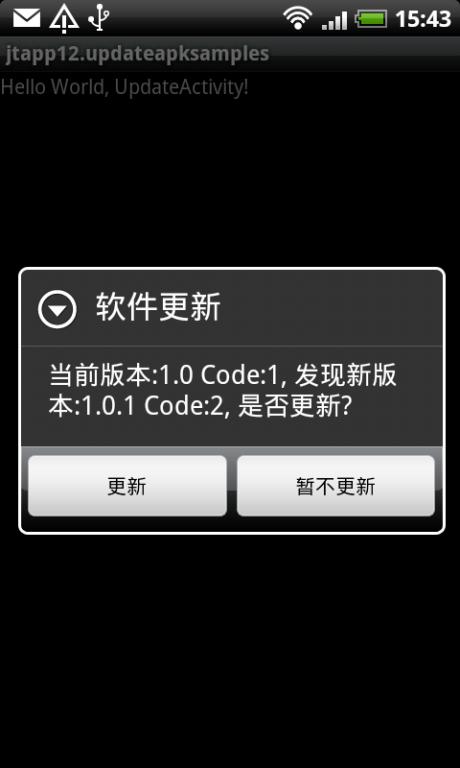Android應用的自動升級、更新模組的實現
我們看到很多Android應用都具有自動更新功能,使用者一鍵就可以完成軟體的升級更新。得益於Android系統的軟體包管理和安裝機制,這一功能實現起來相當簡單,下面我們就來實踐一下。首先給出介面效果:

1. 準備知識
在AndroidManifest.xml裡定義了每個Android apk的版本標識:
其中,android:versionCode和android:versionName兩個欄位分別表示版本程式碼,版本名稱。versionCode是整型數字,versionName是字串。由於version是給使用者看的,不太容易比較大小,升級檢查時,可以以檢查versionCode為主,方便比較出版本的前後大小。<manifest xmlns:android="http://schemas.android.com/apk/res/android" package="com.myapp" android:versionCode="1" android:versionName="1.0.0"> <application></application> </manifest>
那麼,在應用中如何讀取AndroidManifest.xml中的versionCode和versionName呢?可以使用PackageManager的API,參考以下程式碼:
或者在AndroidManifest中將android:versionName="1.2.0"寫成android:versionName="@string/app_versionName",然後在values/strings.xml中新增對應字串,這樣實現之後,就可以使用如下程式碼獲得版本名稱:[此方法好似有些地方會出問題,不建議使用]public static int getVerCode(Context context) { int verCode = -1; try { verCode = context.getPackageManager().getPackageInfo( "com.myapp", 0).versionCode; } catch (NameNotFoundException e) { Log.e(TAG, e.getMessage()); } return verCode; } public static String getVerName(Context context) { String verName = ""; try { verName = context.getPackageManager().getPackageInfo( "com.myapp", 0).versionName; } catch (NameNotFoundException e) { Log.e(TAG, e.getMessage()); } return verName; }
同理,apk的應用名稱可以這樣獲得:public static String getVerName(Context context) { String verName = context.getResources() .getText(R.string.app_versionName).toString(); return verName; }
public static String getAppName(Context context) {
String verName = context.getResources()
.getText(R.string.app_name).toString();
return verName;
}
3. 版本檢查
在服務端放置最新版本的apk檔案,如:http://localhost/myapp/myapp.apk
同時,在服務端放置對應此apk的版本資訊呼叫介面或者檔案,如:http://localhost/myapp/ver.json
ver.json中的內容為:
[{"appname":"jtapp12","apkname":"jtapp-12-updateapksamples.apk","verName":1.0.1,"verCode":2}]private boolean getServerVer () {
try {
String verjson = NetworkTool.getContent(Config.UPDATE_SERVER
+ Config.UPDATE_VERJSON);
JSONArray array = new JSONArray(verjson);
if (array.length() > 0) {
JSONObject obj = array.getJSONObject(0);
try {
newVerCode = Integer.parseInt(obj.getString("verCode"));
newVerName = obj.getString("verName");
} catch (Exception e) {
newVerCode = -1;
newVerName = "";
return false;
}
}
} catch (Exception e) {
Log.e(TAG, e.getMessage());
return false;
}
return true;
}比較伺服器和客戶端的版本,並進行更新操作。
if (getServerVerCode()) {
int vercode = Config.getVerCode(this); // 用到前面第一節寫的方法
if (newVerCode > vercode) {
doNewVersionUpdate(); // 更新新版本
} else {
notNewVersionShow(); // 提示當前為最新版本
}
} private void notNewVersionShow() {
int verCode = Config.getVerCode(this);
String verName = Config.getVerName(this);
StringBuffer sb = new StringBuffer();
sb.append("當前版本:");
sb.append(verName);
sb.append(" Code:");
sb.append(verCode);
sb.append(",/n已是最新版,無需更新!");
Dialog dialog = new AlertDialog.Builder(Update.this).setTitle("軟體更新")
.setMessage(sb.toString())// 設定內容
.setPositiveButton("確定",// 設定確定按鈕
new DialogInterface.OnClickListener() {
@Override
public void onClick(DialogInterface dialog,
int which) {
finish();
}
}).create();// 建立
// 顯示對話方塊
dialog.show();
}
private void doNewVersionUpdate() {
int verCode = Config.getVerCode(this);
String verName = Config.getVerName(this);
StringBuffer sb = new StringBuffer();
sb.append("當前版本:");
sb.append(verName);
sb.append(" Code:");
sb.append(verCode);
sb.append(", 發現新版本:");
sb.append(newVerName);
sb.append(" Code:");
sb.append(newVerCode);
sb.append(", 是否更新?");
Dialog dialog = new AlertDialog.Builder(Update.this)
.setTitle("軟體更新")
.setMessage(sb.toString())
// 設定內容
.setPositiveButton("更新",// 設定確定按鈕
new DialogInterface.OnClickListener() {
@Override
public void onClick(DialogInterface dialog,
int which) {
pBar = new ProgressDialog(Update.this);
pBar.setTitle("正在下載");
pBar.setMessage("請稍候...");
pBar.setProgressStyle(ProgressDialog.STYLE_SPINNER);
downFile(Config.UPDATE_SERVER + Config.UPDATE_APKNAME);
}
})
.setNegativeButton("暫不更新",
new DialogInterface.OnClickListener() {
public void onClick(DialogInterface dialog,
int whichButton) {
// 點選"取消"按鈕之後退出程式
finish();
}
}).create();// 建立
// 顯示對話方塊
dialog.show();
}4. 下載模組
注,本部分參考了前人的相關實現,見 http://apps.hi.baidu.com/share/detail/24172508
void downFile(final String url) {
pBar.show();
new Thread() {
public void run() {
HttpClient client = new DefaultHttpClient();
HttpGet get = new HttpGet(url);
HttpResponse response;
try {
response = client.execute(get);
HttpEntity entity = response.getEntity();
long length = entity.getContentLength();
InputStream is = entity.getContent();
FileOutputStream fileOutputStream = null;
if (is != null) {
File file = new File(
Environment.getExternalStorageDirectory(),
Config.UPDATE_SAVENAME);
fileOutputStream = new FileOutputStream(file);
byte[] buf = new byte[1024];
int ch = -1;
int count = 0;
while ((ch = is.read(buf)) != -1) {
fileOutputStream.write(buf, 0, ch);
count += ch;
if (length > 0) {
}
}
}
fileOutputStream.flush();
if (fileOutputStream != null) {
fileOutputStream.close();
}
down();
} catch (ClientProtocolException e) {
e.printStackTrace();
} catch (IOException e) {
e.printStackTrace();
}
}
}.start();
}下載完成,通過handler通知主ui執行緒將下載對話方塊取消。
void down() {
handler.post(new Runnable() {
public void run() {
pBar.cancel();
update();
}
});
} void update() {
Intent intent = new Intent(Intent.ACTION_VIEW);
intent.setDataAndType(Uri.fromFile(new File(Environment
.getExternalStorageDirectory(), Config.UPDATE_SAVENAME)),
"application/vnd.android.package-archive");
startActivity(intent);
}
如果你將apk應用釋出到market上,那麼,你會發現market內建了類似的模組,可以自動更新或者提醒你是否更新應用。那麼,對於你自己的應用需要自動更新的話,自己內建一個是不是更加方便了呢?本文提到的程式碼大多是在UpdateActivity.java中實現,為了能夠使更新過程更加友好,可以在最初launcher的Activity中建立一個執行緒,用來檢查服務端是否有更新。有更新的時候就啟動UpdateActivity,這樣的使用體驗更加平滑。
本文例程原始碼檢視/下載:
http://code.google.com/p/androidex/source/browse/trunk/jtapp-12-updateapksamples
版權歸個人所有,轉載請註明出處
http://blog.csdn.net/xjanker2/archive/2011/04/06/6303937.aspx
